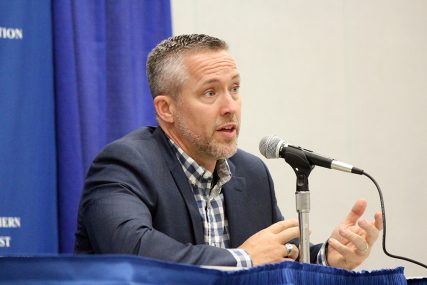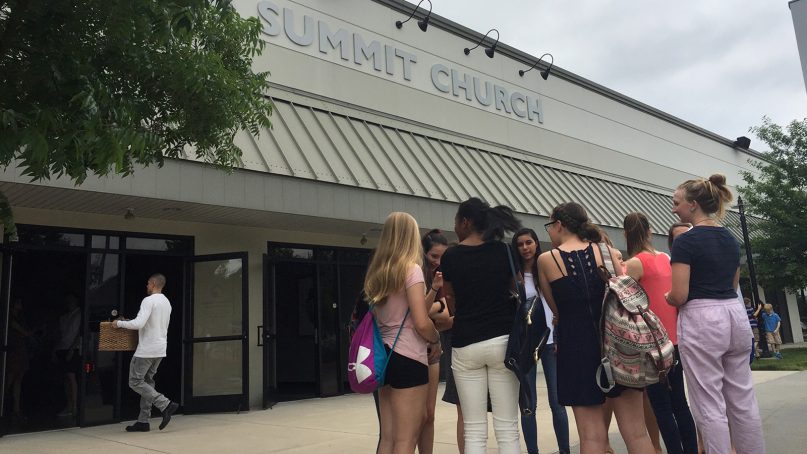DURHAM, N.C. (RNS) — When it comes to protecting children from sexual abuse, The Summit Church has it down.
The church, led by J.D. Greear, president of the Southern Baptist Convention, has put in place strict policies and procedures for anyone who comes in contact with a child, whether it’s a pastor, a youth minister, Sunday school teacher, or a volunteer.
All must undergo a national criminal background check, provide a list of references not including family members, undergo training and submit to being shadowed for a minimum of four weeks.
But this church, with a staff of 200 and a weekend attendance of 10,000 spread across 10 satellite campuses in four counties, is exceedingly rare.
The average Southern Baptist church has a Sunday worship attendance of 145 — and few or no policies in place to protect children from abuse.
“I would say probably less than 5 percent of Southern Baptist churches have similar policies,” said Wade Burleson, a prominent Enid, Okla., pastor who has urged the SBC to create a registry of sexual offenders. (Burleson’s church has many of the same policies as The Summit Church.)
While no church policies or procedures are foolproof, the absence of standard, vetted policies is a problem Southern Baptist leaders are beginning to wrestle with.
More churches, for example, are conducting background checks on new recruits, but those churches are still a minority. Over the past nine years, LifeWay, the SBC’s publishing arm, has helped 16,000 churches perform background checks. But not all of those churches were Southern Baptist.
Sexual abuse within Southern Baptist churches was the subject of a newspaper investigation published this week by The Houston Chronicle/San Antonio Express-News. The three-part series detailed two decades of church sexual abuse and involves some 700 victims.
The series found 380 Southern Baptists who faced allegations of sexual misconduct over the past 20 years. Of those, 35 were able to find new jobs at churches despite documented predatory behavior.
To Greear, the newspaper investigation was not only timely, it was, in his words, “providential.”

J.D. Greear, the SBC president, speaks during the annual meeting in Dallas on June 12, 2018. RNS photo by Adelle M. Banks
On Monday (Feb. 18), he is scheduled to outline a list of recommendations for preventing abuse during an address to the denomination’s executive committee. That list was developed by an advisory group Greear formed in July to study the extent of the sexual abuse crisis within the SBC.
“We didn’t start this conversation on Monday,” Greear said, referring to the day after the first part of the exposé was published. “We started it in July because we recognized there’s a problem.”
In fact, Greear said, setting up the advisory group was the first on his list of priorities after getting elected as president of the SBC in June.
Over the past six months, the group has met with victims, victim advocates, trauma specialists and law enforcement officers to figure out a strategy for helping churches stem a wave of sexual abuse perpetrated by church staff and volunteers.
Greear said the ongoing prevalence of sexual abuse stories was a factor.
“Look at what’s happening in the news,” said Greear. “Whether we’re talking athletics, academics, Hollywood, the media, there seems to be no sphere of society where there are not these problems. We’d be fools to think that out of 47,000 churches it wasn’t an issue for us.”
But it has taken Southern Baptists a while to recognize the problem.
In 2008, SBC leaders rejected a proposal from activists to create an online registry that would have tracked clergy accused or convicted of sexual abuse.
At the time, leaders cited the doctrine of church autonomy. Since each Southern Baptist church is self-governing, they said, the denomination could not force churches to report sexual abuse to a central registry.
On Wednesday, Greear seemed to dismiss that reasoning.
“We don’t want autonomy to be a cover for a lack of responsibility,” he said. “The goal is for predators not to be able to slip from church to church without accountability.”
Unlike the Roman Catholic Church, Southern Baptists have no hierarchy to create top-down policies for churches to follow. Catholics, who have faced their own mammoth sexual abuse crisis, created the Charter for the Protection of Children and Young People, which mandates that all Catholic dioceses, or regions, create safe environments for parishioners.
First adopted in 2002 and amended several times since, the charter requires all U.S. Catholic dioceses to run background checks for all church personnel, report any allegation of abuse to authorities and create review boards, composed primarily of laypeople, to assess allegations. It also calls for an external audit each year to make sure dioceses are complying.
Kathleen McChesney, a former F.B.I. executive who helped Catholic bishops implement the charter, said cases of sexual abuse in churches dropped over the years. There were 22 credible allegations of abuse between 2015 and 2017, down from 101 between 201o and 2014, according to a recent study by the Center for Applied Research in the Apostolate.
“You’d think it’s innate — that adults protect children,” she said. “But for some people, it’s not clear, or they are intent on harming the child.”
Abuse awareness and education may have been the most important aspect of the charter, she added.
Some larger Southern Baptist churches with better resources have adopted some similar measures.
Greear’s church, for example, has a policy in place to respond to allegations of sexual abuse. The policy, created by Brad Hambrick, pastor of counseling at The Summit Church, calls for the church to swiftly report abuse to authorities, such as Child Protective Services, and to set up an emergency response team consisting of three non-church professionals, including a social worker, a physician and a schoolteacher.
The policy, put in place eight years ago, has never been implemented, but its existence, Hambrick thinks, may serve as a deterrent.
“Having preventative policies that you talk about publicly and in the onboarding process is part of announcing to everybody that you’re taking this seriously, that you’re not going to overlook things,” Hambrick said.
Still, Summit pastors with responsibilities to children acknowledge they would appreciate vetted resources to help them protect children.
Asked if he thought the SBC would act this time when it hasn’t before, Greear said the group he assembled wanted to address the issue of abuse head on.
“This is not a group that’s getting together to say, ‘hey, yeah there’s a problem. Let’s move on,’” Greear said. “Caring for the victim and preventing this from happening is by far the biggest concern we have.”





